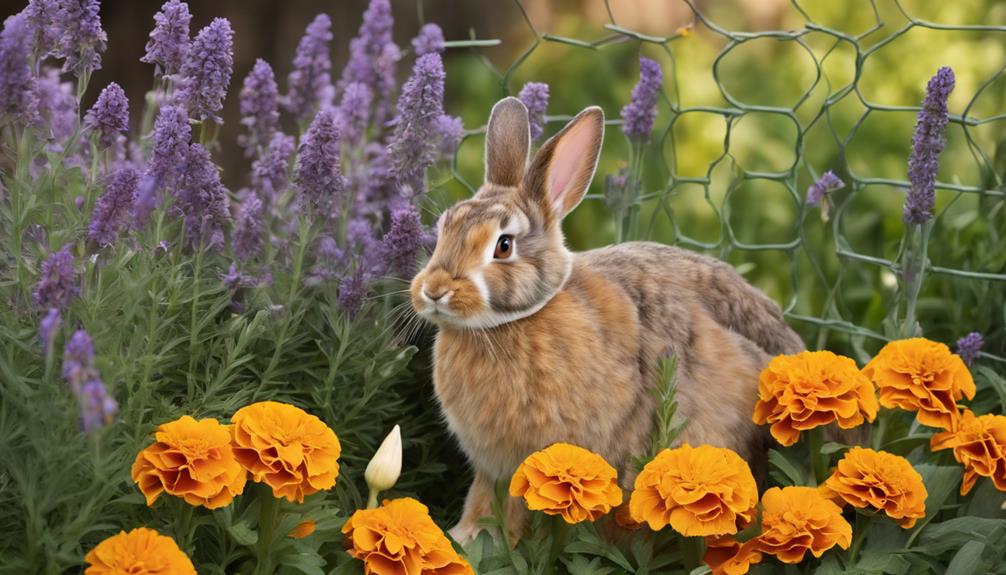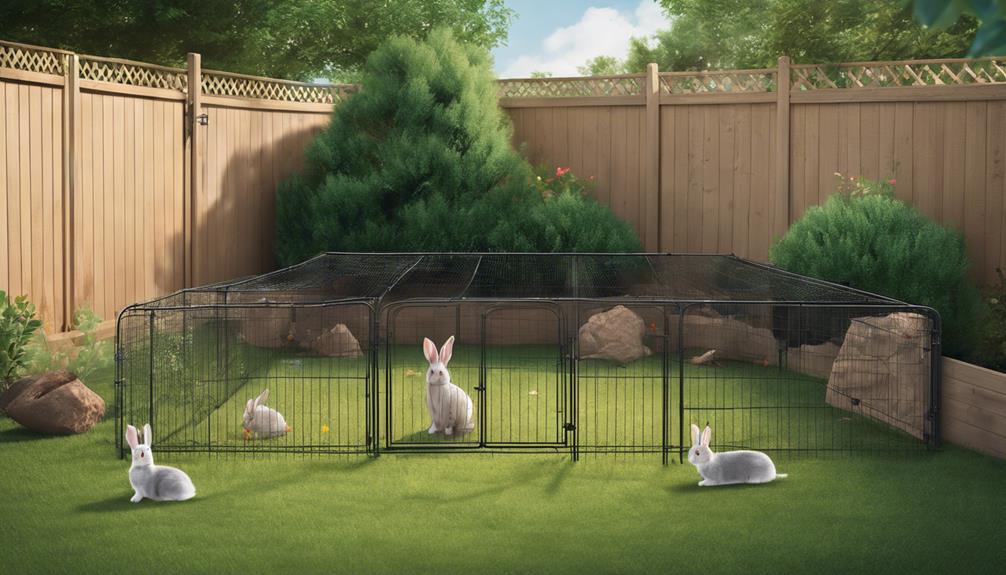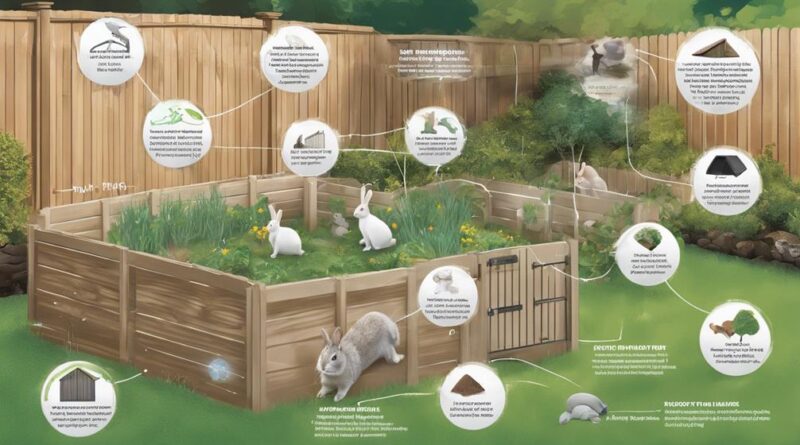Top 10 Tips to Safeguard Rabbits From Predators
To safeguard your rabbits from predators, secure their hutches with predator-proof mesh and elevate them off the ground. Enhance security with motion-activated lights and regular inspections. Manage vegetation by trimming it to reduce hiding spots. Utilize predator-proof fencing and keep rabbits indoors at night. Consider natural repellents and underground barriers to prevent burrowing. Supervise outdoor playtime closely and seek professional predator control services if needed. Implementing these measures can significantly increase the safety and well-being of your rabbits. Your furry friends will thank you for creating a secure environment for them.
Secure Rabbit Hutches
To protect your rabbits from predators, reinforce the security of their hutches by installing sturdy locks and predator-proof mesh. Hutch design plays a crucial role in safeguarding your rabbits. Opt for hutches made of solid materials like wood or metal, as they're more resilient against predator attacks. Ensure that the hutch is elevated off the ground to prevent easy access for ground-dwelling predators like foxes or raccoons. Additionally, consider adding a predator apron—a wire mesh that extends outward from the base of the hutch—to deter burrowing predators such as weasels or snakes.
Understanding predator behavior is key to enhancing hutch security. Predators are often opportunistic and will exploit any vulnerabilities in the hutch design. Conduct a thorough inspection of the hutch regularly to check for any signs of wear and tear that could compromise its integrity. Predators may attempt to chew or scratch their way into the hutch, so ensure that all joints are secure and there are no gaps large enough for a predator to squeeze through.
Install Motion-Activated Lights
Enhance the security of your rabbit hutches by implementing motion-activated lights to deter nocturnal predators effectively. Nighttime surveillance is crucial in protecting your rabbits from potential threats. Motion-activated lights serve as a valuable tool in detecting wildlife predators that may pose a danger to your rabbits.
When predators approach your rabbit hutch at night, the sudden illumination from the motion-activated lights startles them, disrupting their hunting behavior. This unexpected light source can make predators feel exposed and vulnerable, deterring them from continuing their approach towards your rabbits. The element of surprise that these lights provide can be a powerful wildlife deterrent.
By strategically placing motion-activated lights around your rabbit hutch, you create a perimeter of visibility that acts as a protective barrier against nocturnal predators. These lights are triggered by motion, ensuring that any movement around the hutch is immediately illuminated, alerting you to potential threats. This added layer of security not only safeguards your rabbits but also gives you peace of mind knowing that your furry friends are under nighttime surveillance.
Investing in motion-activated lights is a proactive step towards safeguarding your rabbits from predators. These lights act as wildlife deterrents, helping to create a safer environment for your rabbits to thrive in.
Trim Surrounding Vegetation
Trimming the surrounding vegetation near your rabbit hutch is essential for minimizing hiding spots and reducing potential cover for predators. Thinning bushes and clearing undergrowth around the hutch creates a more open environment, making it harder for predators to approach unseen. By maintaining a clear perimeter, you eliminate areas where animals like foxes or raccoons could hide before making a move towards the rabbits.
Thinning bushes is crucial as dense vegetation provides ample hiding spots for predators. By strategically pruning bushes and shrubs near the hutch, you create a less hospitable environment for predators looking for cover. Additionally, clearing undergrowth removes potential hiding spots closer to the ground, reducing the chances of predators sneaking up on your rabbits from below.
Observing the surroundings of the rabbit hutch regularly is important to ensure that the vegetation remains trimmed. Keep an eye out for any regrowth or areas that need further attention. By staying proactive in maintaining a well-groomed perimeter, you significantly decrease the opportunities for predators to lurk around the hutch undetected. Remember, a well-manicured landscape around your rabbit hutch is a key step in safeguarding your rabbits from potential threats.
Use Predator-Proof Fencing
Utilize predator-proof fencing to establish a secure barrier around your rabbit hutch, effectively deterring potential threats from accessing your rabbits. When selecting fencing materials, consider using mesh netting with small gaps to prevent predators from squeezing through or reaching in. The mesh should be durable and extend at least 12 inches below ground to deter burrowing intruders.
Electric wire can be a valuable addition to your predator-proof fencing. Install it a few inches above the ground and again at a higher level to discourage both ground predators and climbers. Ensure the electric wire is properly grounded and adjusted to deliver a mild but effective shock to deter predators without causing harm.
Regularly inspect the fencing for any signs of wear or damage. Repair any holes promptly and check that the electric wire is functioning correctly. Over time, vegetation may grow close to the fencing, potentially compromising its effectiveness. Trim back any plants that could provide a bridge for predators to access the enclosure.
Remember that the goal of predator-proof fencing is to create a barrier that's challenging for predators to breach. By combining mesh netting with electric wire and proper maintenance, you can significantly enhance the security of your rabbit hutch and protect your furry companions from harm.
Keep Rabbits Indoors at Night
Inspect the surroundings around your rabbit hutch to ensure a secure environment before nightfall, as keeping rabbits indoors during the night is a proactive measure to safeguard them from potential nocturnal predators. When transitioning your rabbits indoors for the night, consider providing indoor enrichment to keep them mentally stimulated. This can include chew toys, tunnels, and platforms for them to explore, promoting their natural behaviors and reducing stress levels.
Establishing nighttime routines is crucial for the well-being of your rabbits. Ensure their indoor enclosure is spacious enough for them to move around comfortably and exhibit natural behaviors like hopping and stretching. Additionally, provide hiding spots or enclosed areas within the enclosure where they can retreat if they feel threatened. This will give them a sense of security, especially during the night when they may be more vulnerable.
Before nightfall, check that the indoor environment is safe and free from any potential hazards. Remove any toxic plants, secure electrical cords, and ensure there are no small objects that could be ingested. By creating a safe and enriching indoor space for your rabbits, you aren't only protecting them from predators but also promoting their overall well-being and happiness.
Add Noise Deterrents
Consider implementing noise deterrents around your rabbit hutch to help deter potential predators and keep your rabbits safe during the night. Noise distractions can be an effective method for predator prevention as they startle and deter them from approaching. Predators rely on stealth when hunting, so unexpected sounds can disrupt their plans.
One sound deterrent you can use is a motion-activated alarm. These devices emit loud noises when triggered by movement, scaring away predators. Place these alarms strategically around the rabbit hutch perimeter to create a barrier of sound protection. Another option is to install wind chimes or bells near the hutch. The gentle tinkling of these objects can serve as a constant reminder to predators that they aren't alone, potentially deterring them from getting too close.
Additionally, consider playing recorded sounds of larger animals in the vicinity of your rabbit hutch. Predators may be cautious about approaching if they believe there are larger, more dangerous creatures nearby. This auditory illusion can be a simple yet effective method for keeping predators at bay.
Utilize Natural Repellents

To naturally repel predators from your rabbit hutch, explore incorporating aromatic plants known for their deterrent properties in the surrounding area. Herbal deterrents have shown varying degrees of effectiveness in deterring predators from approaching rabbit enclosures. Plants like lavender, mint, and marigold emit strong scents that many animals find unpleasant, potentially keeping them away from your rabbits.
Creating a DIY repellent using these herbs can be a cost-effective and natural way to protect your rabbits. You can make a simple herbal spray by steeping a combination of these plants in water and then spraying the mixture around the perimeter of the hutch. Reapply the spray every few days or after rainfall to ensure its effectiveness.
Observationally, the aromatic compounds released by these plants act as a natural deterrent to predators who rely heavily on their sense of smell. The application of herbal repellents can create a barrier that signals danger to potential threats, discouraging them from coming too close to the rabbits.
Incorporating herbal deterrents into your rabbit care routine can be a proactive measure in safeguarding your rabbits from predators. By utilizing the natural repellent properties of these plants, you can enhance the security of your rabbit hutch in a way that's eco-friendly and safe for your pets.
Implement Underground Barriers
Exploring additional measures beyond herbal deterrents, one effective strategy to enhance the security of your rabbit hutch is to implement underground barriers against predators. Burrow prevention is crucial in safeguarding your rabbits from potential threats. Predators such as foxes, raccoons, and even domesticated animals like cats and dogs can dig under traditional fencing to access your rabbits. To counter this, consider burying hardware cloth or wire mesh at least 1 to 2 feet deep around the perimeter of the hutch. This physical barrier acts as a deterrent, making it challenging for predators to tunnel their way in.
Predator avoidance is key when designing underground barriers. Ensure that the barrier extends both vertically and horizontally to prevent digging and burrowing attempts. Regularly inspect the barrier for any signs of wear or damage and promptly repair them to maintain its effectiveness. Additionally, when burying the barrier, angle it outward to deter predators from attempting to dig near the hutch.
Implementing underground barriers not only protects your rabbits from potential harm but also provides peace of mind knowing that they're secure in their environment. Remember, a well-constructed underground barrier is a proactive approach to predator prevention, ensuring the safety and well-being of your beloved rabbits.
Supervise Outdoor Playtime

Supervise outdoor playtime diligently to ensure the safety and well-being of your rabbits. When allowing your rabbits to roam outside their enclosure, it's crucial to be attentive and proactive in protecting them from potential predators. Here are essential guidelines for playtime supervision and outdoor safety:
- Stay Alert: Monitor your rabbits closely while they're outside to quickly identify any signs of danger or distress. Predators can approach swiftly, so being vigilant is key to preventing attacks.
- Secure Enclosure: Ensure the play area is secure with no gaps or holes that predators could exploit to gain access. Regularly inspect the fencing for any damages that might compromise its integrity.
- Limited Access: Limit outdoor playtime to daylight hours when visibility is better, and predators are less active. Avoid letting your rabbits out during dawn or dusk when many predators are most active.
- Provide Shelter: Have hiding spots or shelters in the play area where rabbits can retreat if they sense danger. Natural elements like bushes or small wooden shelters can offer refuge.
Seek Local Predator Control Services
Consider engaging local predator control services to enhance the protection of your rabbits from potential threats in the surrounding environment. Hiring professionals who specialize in predator control can significantly reduce the risk of harm to your rabbits. These experts have the knowledge and experience to identify common predators in your area and implement effective strategies to deter them.
Community involvement is crucial when it comes to safeguarding your rabbits. Local predator control services often work closely with residents to create a safer environment for pets. By collaborating with these professionals, you can benefit from their expertise while also contributing to the overall welfare of the community. This collaborative approach fosters a sense of shared responsibility and can lead to more effective predator control measures.
When seeking local predator control services, look for providers with a proven track record of success. Check for certifications and licenses to ensure that you're working with reputable professionals. Additionally, inquire about the methods they use for predator deterrence to ensure that they align with your values and preferences. By taking these steps, you can create a safer outdoor environment for your rabbits and enjoy peace of mind knowing that they're well-protected.
Frequently Asked Questions
Can Rabbits Defend Themselves Against Predators?
Rabbits rely on self-defense strategies like speed, agility, and burrowing to evade predators. Their behavior is instinctively tuned to detect predation risk, prompting them to freeze, flee, or thump their hind legs as a warning signal.
While rabbits can't physically overpower most predators, their keen senses and quick reflexes help them avoid becoming prey. Understanding these natural defense mechanisms is crucial for safeguarding rabbits from potential threats in the wild.
How Do I Know if My Area Has Many Predators?
To determine the predator population in your area and ensure rabbit safety, observe signs like tracks, scat, and missing pets. Listen for nighttime sounds indicating predators. Set up trail cameras to capture wildlife activity.
Consult local wildlife authorities for information on prevalent predators. Conducting a thorough assessment will help you gauge the potential risks and take appropriate measures to safeguard your rabbits.
What Are Common Signs of Predator Activity?
To identify predator behavior and ensure rabbit protection, observe for tracks near burrows, scattered feathers or fur, disturbed vegetation, and droppings. Predators may leave scratch marks on trees or fences, dig holes, or show signs of scent marking.
Keep an eye out for unusual animal sounds or the absence of small wildlife. Understanding common signs of predator activity is key to safeguarding your rabbits effectively.
Are There Specific Plants That Deter Predators?
Certain plants act as natural deterrents for predators due to their strong scents or tastes. These plants can help in predator prevention by making the area less appealing to potential threats.
Examples of such plants include marigolds, lavender, and rosemary. These plants not only serve as a natural barrier against predators but also add beauty to your garden while keeping your rabbits safe.
How Often Should I Check for Signs of Predators?
You should regularly check for signs of predators to ensure effective predator prevention. Monitoring behavior like changes in rabbit activity, disturbed surroundings, or presence of unfamiliar scents can indicate potential threats.
Conduct these checks at least daily, focusing on vulnerable times like dusk and dawn. Promptly addressing any signs can help safeguard your rabbits from harm and maintain a secure environment for them.
Conclusion
In conclusion, safeguarding rabbits from predators is crucial to their safety and well-being. By following these top 10 tips, you can create a secure environment for your rabbits to thrive in.
From securing their hutches to utilizing natural repellents, every precaution taken helps protect these vulnerable animals from potential harm. Remember to stay vigilant and proactive in ensuring the safety of your rabbits from predators.
